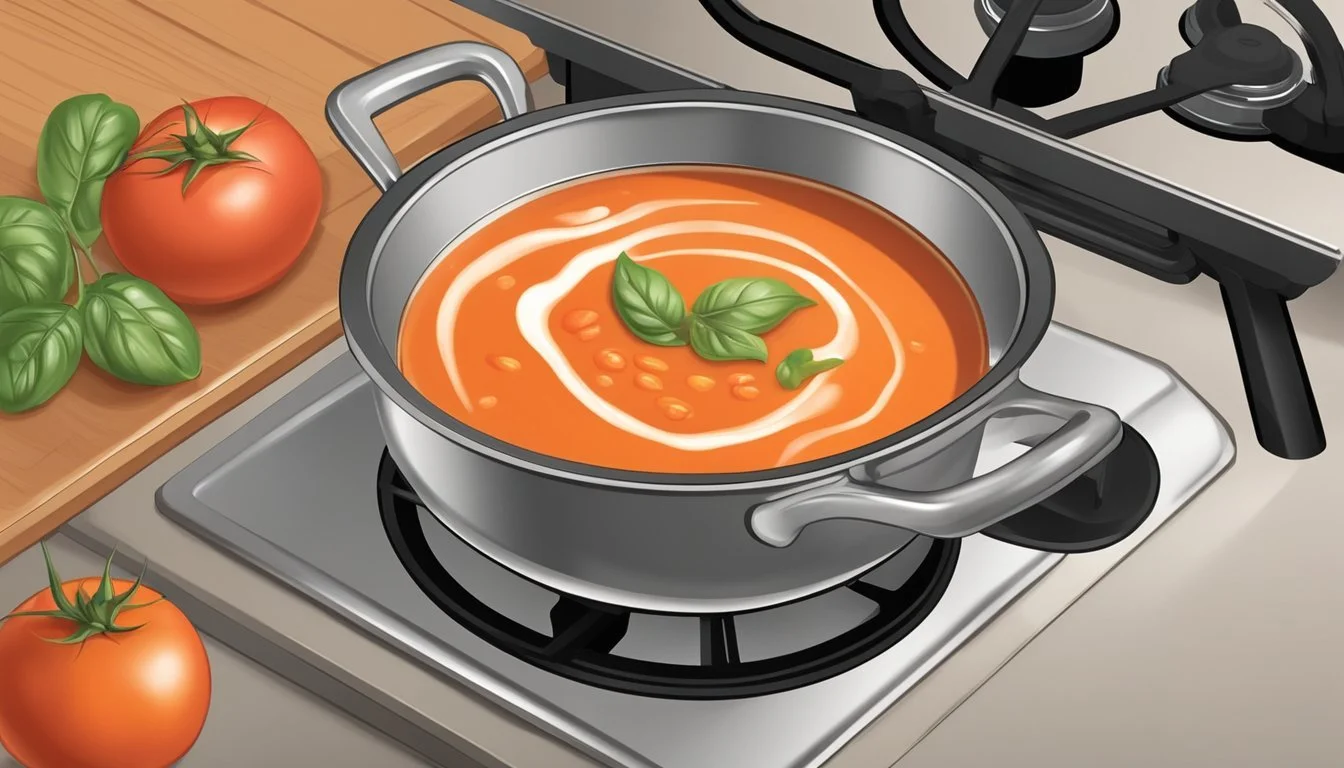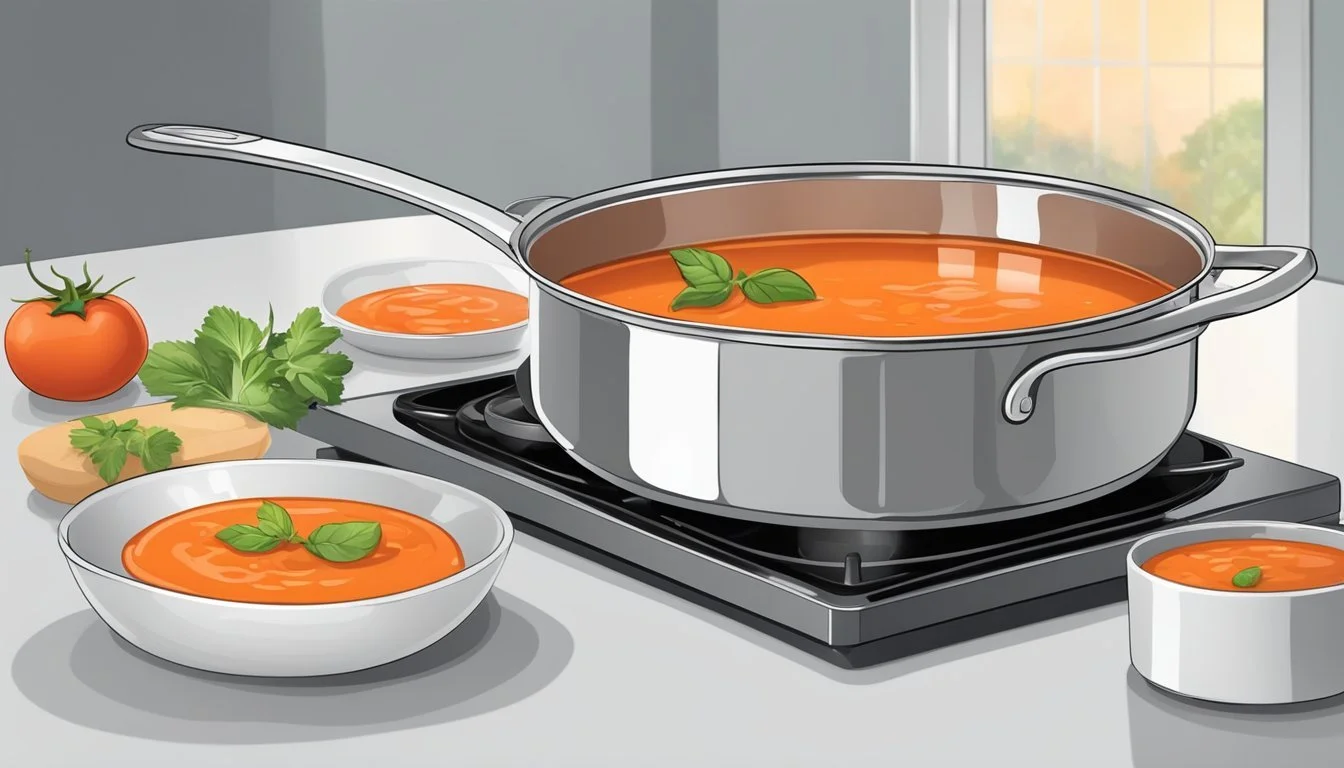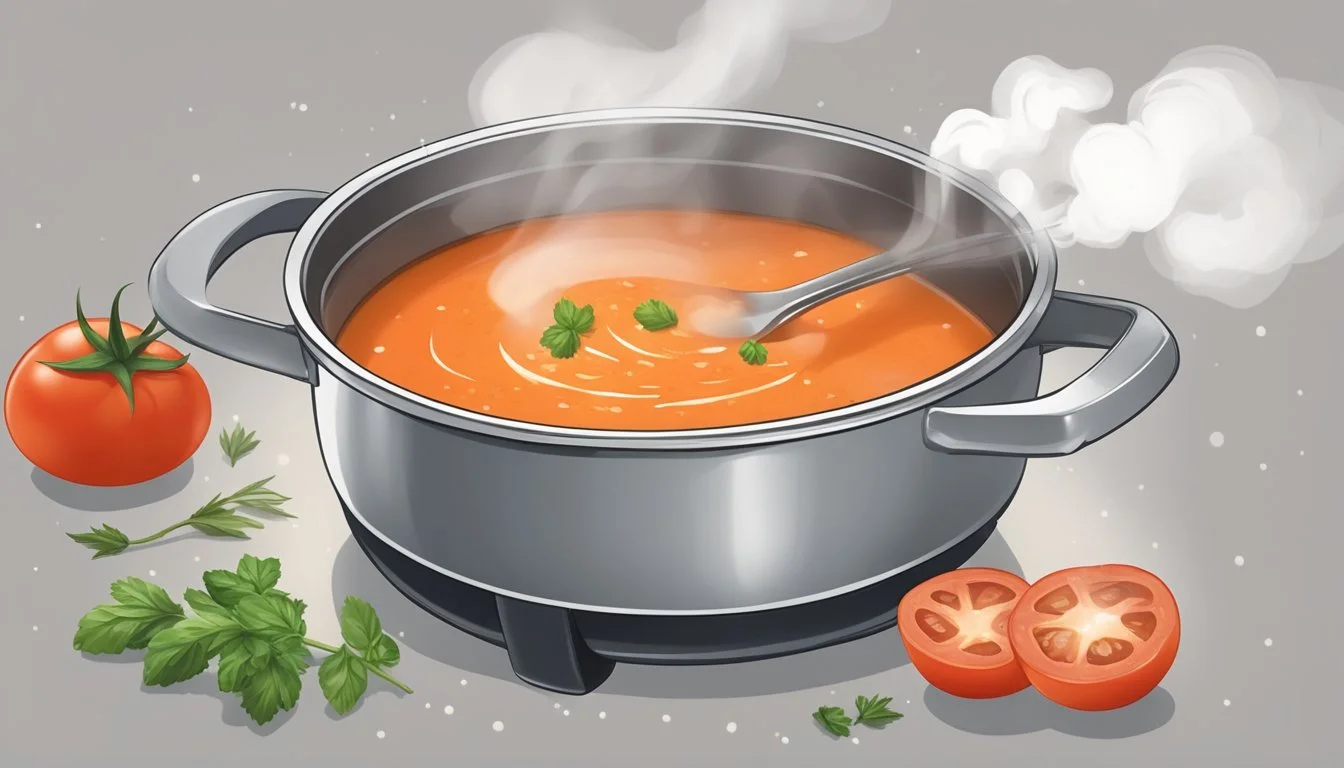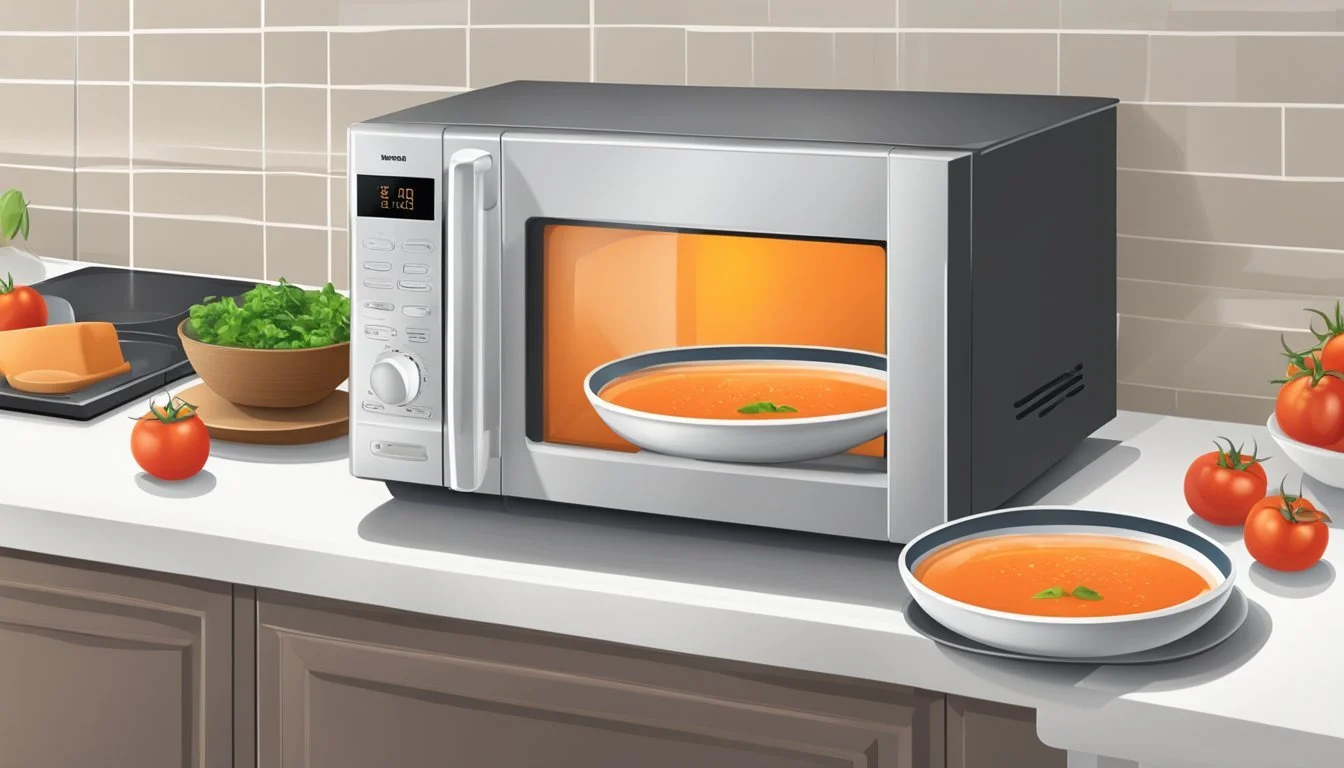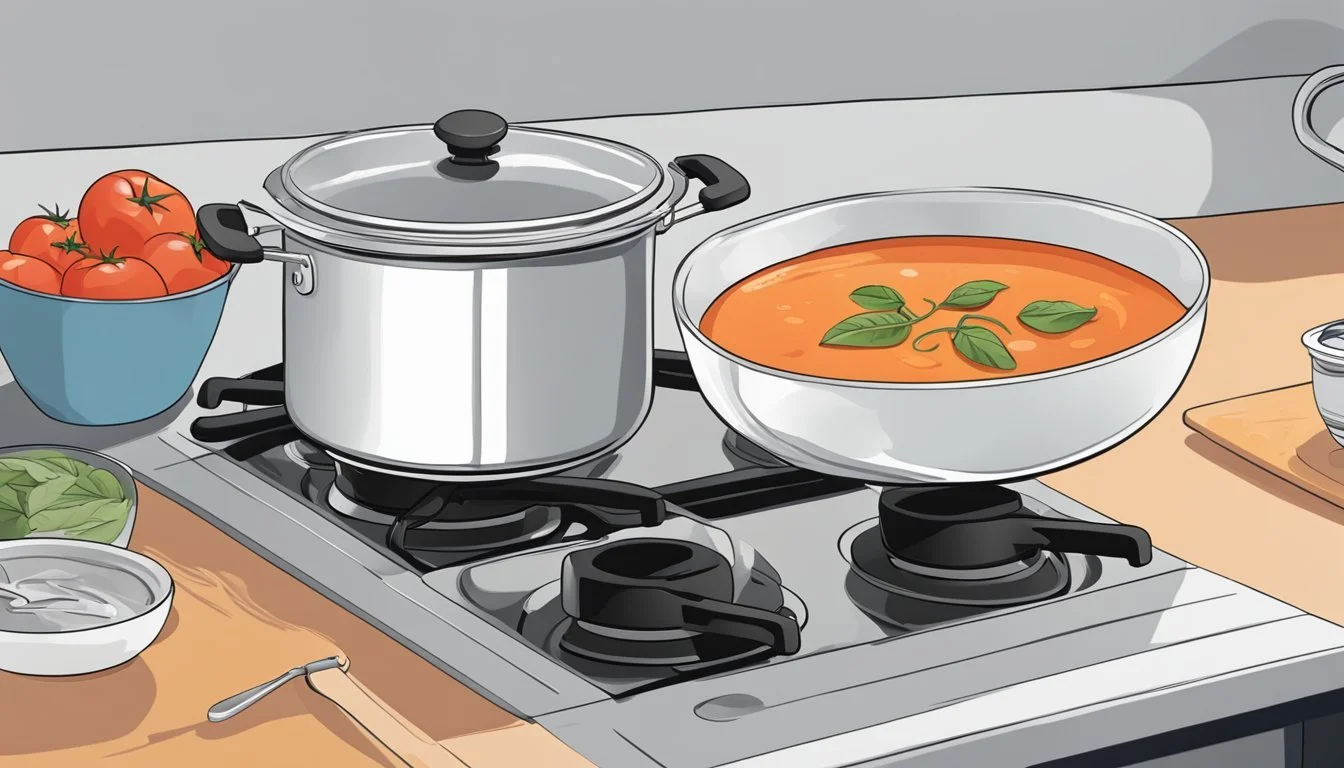Best Way to Reheat Creamy Tomato Soup
Tips for Maintaining Texture & Taste
Creamy tomato soup, with its velvety texture and rich flavor, is a comfort food favorite. Preserving its smoothness and taste during reheating is crucial for an enjoyable experience. Inappropriate reheating methods can lead to separation, a grainy texture, and diminished flavor. It’s essential to reheat the soup gently and slowly to maintain its creamy consistency and to ensure that the flavors remain as intended.
When aiming to preserve the quality of creamy tomato soup, understanding the nature of its ingredients is key. Cream-based soups require careful handling as dairy products are prone to curdling and separation under high heat. They demand a gentler approach when being brought back to serving temperature. A steady and controlled heat source, like a stovetop at a medium setting, helps in bringing the soup back to its optimum temperature without risking the integrity of its creaminess and taste.
Reheating the soup in measured intervals while stirring frequently can further guarantee an even temperature distribution, effectively safeguarding the soup’s texture and flavor profile. Warming the soup slowly not only enhances its aromatic qualities but also allows for adjustments to be made easily if the soup starts to become too hot. This attention to detail ensures that each spoonful of creamy tomato soup remains as delightful as when it was first prepared.
Understanding Creamy Tomato Soup Fundamentals
In considering the best methods for reheating creamy tomato soup, one must understand its components and the factors that contribute to its flavor and texture.
The Composition of Creamy Tomato Soup
Creamy tomato soup typically combines ripe tomatoes (What wine goes well with tomatoes?), a base of aromatics like onions and garlic, and a rich element such as heavy cream or a roux made from butter and flour. In homemade soup, these fresh ingredients are blended together to create a smooth, velvety texture that's both comforting and satisfying. Often, additional seasonings are added, including but not limited to basil, oregano, salt, and pepper, which enhance the natural flavors of the vegetables.
Factors Affecting Soup Flavor and Texture
Flavor: The flavor of a creamy soup can be influenced by the quality of the tomatoes and the balance of seasonings. If the tomatoes are not fully ripe or the seasonings are not well proportioned, the soup may lose its depth of flavor when reheated.
Texture: Factors that affect the texture of cream-based soups include:
Temperature Control: Reheating must be done gently to avoid separating the cream.
Cooking Time: Overcooking can lead to a breakdown of the tomato structure, resulting in a grainy texture.
Stirring: Careful stirring is important to maintain an even consistency.
When reheating, it's crucial to consider these factors to preserve the smoothness and flavor that make a creamy tomato soup particularly enjoyable.
Safe Soup Storage Techniques
Preserving the quality of creamy tomato soup after it has been made is essential to enjoying its flavor and texture during reheating. Proper storage techniques mitigate bacterial growth and freezer burn, ensuring that the soup maintains freshness whether in the refrigerator or freezer.
Refrigerator Storage for Optimal Freshness
For short-term storage, placing leftover soup in the refrigerator is the best option. It's crucial to use an airtight container to preserve the soup's flavor and prevent absorption of other odors. Here are key steps for refrigerator storage:
Cool the soup to room temperature within two hours to minimize the risk of bacterial growth.
Transfer the soup into an airtight container to keep it fresh.
Store the soup at a consistent temperature in the refrigerator, ideally below 40°F (4°C).
Freezer Guidelines for Creamy Tomato Soup
When storing soup for more than a few days, freezing is the way to go. Use these guidelines for freezer storage:
Cool the soup properly before freezing to preserve its smoothness and flavor.
Pour the soup into freezer-safe containers or bags, leaving some space to allow for expansion as it freezes.
Label each container with the date and contents for easy identification and to track how long it's been stored.
Preventing Bacterial Growth and Freezer Burn
To extend the soup's shelf life and maintain its quality, preventing bacterial growth and freezer burn is paramount. Carefully follow these practices:
Ensure containers are sealed tightly to prevent exposure to air, which can cause freezer burn.
Consume frozen soup within three months to enjoy its best quality and to prevent nutrient degradation.
Reheat only the amount of soup you intend to serve, reducing the number of times the soup is cycled through the cooling and reheating process.
Reheating Soup to Maintain Quality
To preserve the quality and taste of creamy tomato soup when reheating, one should focus on maintaining an even temperature and preventing curdling. The right reheating method can ensure the soup's smoothness and flavor are as close to its original state as possible.
Stovetop Reheating for Even Temperature
Reheating soup on the stovetop allows for better control over the heating process. Heating creamy tomato soup should be done gently—soup leftovers need to be placed in a saucepan over low heat. Bring the soup to a gentle simmer, and stir occasionally to ensure even heating and prevent scorching. It is crucial to avoid boiling the soup, as high heat can cause separation and curdling in dairy-based soups.
Microwave Heating: Using Medium Power and Stirring
When reheating in a microwave, use a microwave-safe bowl and cover it with a lid or microwave-safe cover to allow steam to escape. Reheat the soup at medium power in one-minute intervals, stirring between each to distribute heat throughout the soup uniformly. This method prevents hot spots and helps maintain the soup's smooth texture.
Thawing and Defrosting Leftovers Properly
If the soup has been frozen, it is important to thaw it correctly to maintain quality. Thaw the soup in the refrigerator overnight to ensure even temperature distribution when reheating. Defrosting in the microwave should be done at a defrost or low setting, stirring periodically, before proceeding with standard reheating methods. Proper thawing will also prevent the soup's elements from separating or curdling.
Enhancing Flavor and Texture
When reheating creamy tomato soup, careful consideration of fresh ingredients and seasonings can significantly elevate the dish's overall sensory appeal.
Using Fresh Ingredients During Reheat
Incorporating fresh ingredients such as diced tomatoes or finely chopped onions into the reheating process can enrich the soup’s flavor and texture. Heating these fresh additions together with the soup helps meld the flavors and imparts a satisfying freshness to every spoonful.
Tomato: Small, ripe diced tomatoes can introduce a vibrant burst.
Onion: Finely minced onions become soft and translucent, contributing a subtle depth.
Incorporating Fresh Herbs and Seasonings
Fresh herbs and a judicious use of seasonings are the soul of a flavorful soup. Adding fresh basil leaves or a sprinkle of freshly ground black pepper during reheating can transform a soup from good to great.
Basil: Delicate and aromatic, ripped basil leaves merge their flavor with the tomato base.
Black Pepper: A touch of freshly ground pepper should be added for a subtle, warm spice that complements the tomatoes.
Adjustments for Cream and Butter Additions
For a richer texture, a swirl of butter or a splash of heavy cream can be infused at the end of reheating. They should be stirred in gently to ensure a smooth consistency. The butter adds a luxuriously creamy mouthfeel, while the cream can enrich the soup's body without overwhelming the tomato flavor.
Butter: Unsalted or lightly salted butter should be considered to control the soup’s saltiness.
Heavy Cream: Just a splash, as too much can dilute the tomato essences.
Using kosher salt or a dash of good quality extra virgin olive oil can make a subtle yet profound difference. These should be added to taste, considering the balance of flavors in the soup.
Serving and Pairing
When reheating creamy tomato soup, the goal is to preserve its velvety texture and robust flavor. Proven pairings elevate the dish, transforming the soup from a simple offering to a satisfying meal.
Optimal Serving Temperature for Enjoyment
The ideal serving temperature for creamy tomato soup is about 155-165°F. This range is hot enough to release the soup's full flavor profile while remaining comfortable to eat, ensuring each spoonful is as enjoyable as the last.
Classic Combos: Grilled Cheese and Croutons
Grilled Cheese: A buttery, crispy grilled cheese sandwich is the quintessential companion to tomato soup. The melty cheese and toasted bread offer a satisfying contrast in textures and flavors.
Croutons: For added crunch and flavor, homemade or store-bought croutons are an excellent topping. They lend a delightful crispiness that complements the soup's creaminess.
Creative Toppings and Variations
One can introduce a variety of toppings and stir-ins to enhance the soup's character. Experiment with:
Cheese Variations: Sprinkle a mix of Parmesan, cheddar, or mozzarella for a multi-dimensional cheese experience.
Herbs and Spices: Fresh basil or a dash of paprika can introduce an aromatic touch and subtle warmth to the dish.
Additional Ingredients: For those desiring a heartier main course, consider stirring in cooked pasta, rice, or even protein such as shredded chicken or turkey meatballs.
Special Considerations
When reheating creamy tomato soup, a cook must account for ingredients like pasta, grains, and vegetables to maintain texture, and consider dietary preferences for those following vegan or vegetarian diets.
Handling Creamy Tomato Soup with Pasta or Grains
When creamy tomato soup includes pasta or grains, optimal reheating requires gentle heat application. Pasta or grains should not be overcooked; hence, they recommend stirring the soup occasionally and using only medium heat to prevent the pasta or grains from becoming mushy.
Heat gently
Stir occasionally
Vegetables: Reheating without Overcooking
Vegetables in tomato soup should retain their texture and nutritional value. It's important to not let them become too soft and lose their vibrant color. The soup should be reheated just enough so that the vegetables are warmed through but not overcooked.
Vegetables:
Warm through
Avoid overcooking
Vegan and Vegetarian Adaptations to Tomato Soup Recipe
One should be mindful of ingredients in vegan or vegetarian creamy tomato soups. If the original recipe requires dairy, substitutes such as coconut milk, almond milk, or soy milk can be used. It's crucial to avoid high heat as these milk alternatives can separate and affect the soup's texture.
Vegan/Vegetarian:
Use dairy alternatives (coconut, almond, soy milk)
Low heat to prevent separation
Modern Kitchen Appliance Use
When reheating creamy tomato soup, the right modern kitchen appliances can help retain its smooth texture and rich flavor. This section explores effective ways to reheat using an Instant Pot or crockpot, as well as blending techniques to rejuvenate your soup's consistency.
Reheating in an Instant Pot or Crockpot
The Instant Pot offers a gentle reheating method that can preserve the delicate balance of a creamy tomato soup. Users should:
Place the soup in the Instant Pot.
Select the "Keep Warm" setting, allowing the soup to reach the desired temperature without scorching the cream.
Stir occasionally to ensure even heat distribution.
Similarly, a crockpot is well-suited for reheating creamy soups on a low setting. Here’s how:
Pour the soup into the crockpot.
Set it to the low heat setting, and allow the soup to slowly warm up.
Stir every 15-20 minutes, closely monitoring to avoid overcooking.
Both appliances prevent the rapid temperature change that can cause separation or curdling, which commonly occurs on a traditional stovetop or in a microwave.
Blending Techniques with Food Processors and Blenders
Occasionally, a reheated creamy tomato soup may need texture adjustment. A kitchen blender or food processor can smooth out any inconsistency. For best results:
Transfer the reheated soup into a blender or Vitamix.
Blend on a low to medium setting until the desired smoothness is achieved.
If the soup has cooled in the process, return it to the heat for a quick warm-up.
It is important to blend the soup in batches if necessary, to avoid overfilling and ensure a uniform consistency. These small processing steps maintain the creaminess and flavor of the soup to near-original state.
Economical Tips and Meal Prep
When it comes to enjoying creamy tomato soup, making smart choices with meal prep and storage can save both time and money, while preserving the soup's delightful taste.
Saving Time and Money While Maximizing Taste
To economize both time and expenses, individuals should consider using quality stock as the soup base, leveraging sales for bulk purchases of tomatoes, onions, and cream. Once the ingredients are acquired, they can cook the creamy tomato soup in larger quantities. This approach reduces the cost per serving and saves time when future meals require a quick and satisfying solution.
Buy in Bulk: Purchase non-perishable ingredients like stock in bulk during sales.
Cook Once, Eat Multiple Times: Prepare a large batch of soup to avoid starting from scratch for every meal.
Advanced Preparation and Cooking in Batches
Cooking soup in batches and storing it properly ensures that the creamy tomato soup retains its flavor and smoothness. Cooling the soup quickly and transferring it into storage containers can prevent bacterial growth. Freeze the soup in portion-sized containers or freezer bags, laying them flat to save space.
Cooling Soup Rapidly: For safety and quality, rapidly cool the soup before freezing.
Freezing Technique: Utilize flat storage or bags to maximize freezer space and quicken defrosting times.
Labeling and Organizing Stored Soup
A key part of meal prep is the proper labeling and organization of stored food. Label each container with the soup's name, cooking date, and 'best by' date. This strategy not only helps keep track of inventory but also contributes to food safety.
Labels Should Include:
Soup Name: Creamy Tomato Soup
Cook Date: Date of cooking or batch preparation
Best By: A date to ensure the soup is consumed while at its best quality
Maintaining an inventory system, whether alphabetical or by date, facilitates efficient utilization and rotation of stored soup, ensuring no batch goes to waste.

